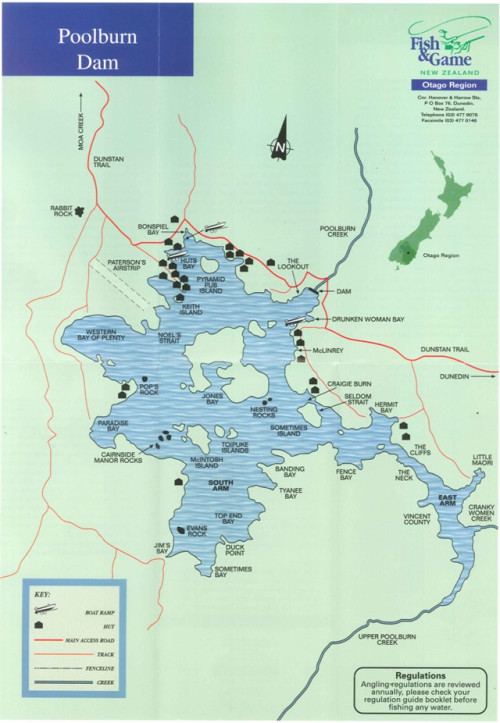History
Poolburn Dam is a popular recreational area for anglers, boaties, picnickers and others who just want to enjoy the solitude of the water and unusual rock tors of this part of Central Otago. This reservoir is situated on the Ida Valley side of the Rough Ridge Range. It was completed in 1931 as a storage area for irrigation water to feed the fertile land of the Ida Valley. It covers over 300 hectares when full and is administered by the Ida Valley Irrigation Company. The area now covered by water once had five hotels alongside this popular goldfields road (part of the Old Dunstan Trail). The most famous was the Drunken Woman Inn, named by travelers after its owner. The dam has had both brown and rainbow trout introduced to its water, but has evolved as a brown trout fishery. The last recorded rainbow trout was caught by Andrew Hays in 1953.
Getting There
There are two access points to the water. The most popular is from the Poolburn Hotel on the Ida Valley Road. Travel up Moa Creek Road and turn left just past the old school into Webster Lane, which is a gravel road. The dam is signposted from this point past the old Moa Creek Hotel, where a right turn is made.
There are generally no gates, but please drive slowly as there is often stock on the road from this point to the dam. This is part of the Old Dunstan Trail from the Styx Basin. The alternative access from the Styx Basin end is not recommended as it is not graveled and has several gates to open.
Access
There are several access places around the lake that can be used. Some of these cross private land, and many can only be used by 4WD vehicles. Please respect this land and the stock grazing on it. Do not dig for worms and make sure you take all rubbish away with you.
Please select image for larger view.
Methods
All legal methods can be used. The worm is popular, but the fly and spin fishing appear to give better results. Boats can be used, but there are so many submerged rocks that trolling is difficult and can be expensive on propellers and lures.
Bait
There are two methods of bait angling employed. The traditional method is using a sinker, and the other running a float with the bait suspended a metre or so below. The latter method is used by fishing with the wind behind you. If using the traditional method fish close to the shore as the trout are often feeding in a about 1.5m depth. Again, do not dig for worms around the lake edges!
Spinning
Spin anglers have most success with fishing along the shallow margins. Normal size lures are used early in the season, but as the weather gets warmer smaller lures such as 7g black Wedges and Tylos are used. Rapalas work very well especially around the rocky areas. Try the ‘rainbow trout’ or ‘perch’ colours.
Trolling
Trolling can give some great result, especially when there is a breeze ruffling the water surface. When the sky is drak, use silver or other light-coloured lures and conversely when the day is bright, use darker patterns. It is common to attach a feathered lure approximately 50cm in front of your main lure on this water. Those mentioned in the flyfishing section are best. Other lures used are copper Zed Spinners, silver, black and gold or banana Tobys, Veltic and Mepps spinners in a variety of colours and King Cobras or Tassie Devils in traffic light or green and gold colours. Most trolling is done with an ordinary spinning gear and about 100M of line out.
Flyfishing
Fly anglers start the season using feathered lures such as green Woolly Bugger, Hamill’s Killer, Monsum’s Bully and Mrs Simpson in either yellow or red. These are generally fished on a floating line with a longish leader. Dry flies used early in the season are brown and green beetle imitations such as Royal Wulff and Cochybondhu. After Christmas cicadas and hoppers are the order of the day, then late in summer and into autumn patterns such as Black Gnat, Loves Lure and Peveril of the Peak are used to imitate adult diving beetles. There are some amazing midge hatches especially at dawn and dusk and a good slection of midge pupa patterns should be carried along with the standard selection of Stillwater nymphs including Black and Peascock Snail, Corixa and Damselfly.
